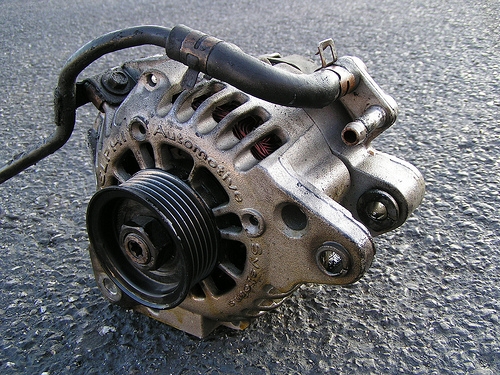
When the ignition is turned on, an electrical current is sent from the battery to the alternator's voltage regulator via the "exciter" wire. The voltage regulator modulates this current to produce a constant direct current (DC) voltage that runs through the rotor, which is a solid iron core wound in a coil of wire. This current generates a magnetic field through the coiled wire. The rotor is spun by a belt driven by the automobile's motor.
As the engine is started, a belt connected to the alternator spins the rotor within the stator. The stator consists of three sets, or phases, of iron cored conductors which are wound in wires and does not move inside of the alternator. As the rotor spins inside of the stator, the magnetic field rotates, sweeping its positive and negative poles across the stator's wire coil phases and generates an electrical alternating current (AC).
The AC current from the stator is sent though the rectifier, a series of output diodes, which allows a current to flow only in one direction, converting alternating current to direct current. These output diodes consist of six diodes, one pair for each phase of the stator. Three diodes convert negative portion of the current while the remaining diodes convert the positive current. Once converted to DC, the current is routed from the rectifier's output diodes to the battery and other electrical components.
A separate diode trio, consisting of one diode per phase, within the rectifier sends DC current back to the voltage regulator. The voltage regulator monitors the incoming DC current, adjusting for higher or lower voltage, as it travels back to the rotor. As the alternator generates its own electrical current, the electrical feed from the exciter wire powering the field current is discontinued.